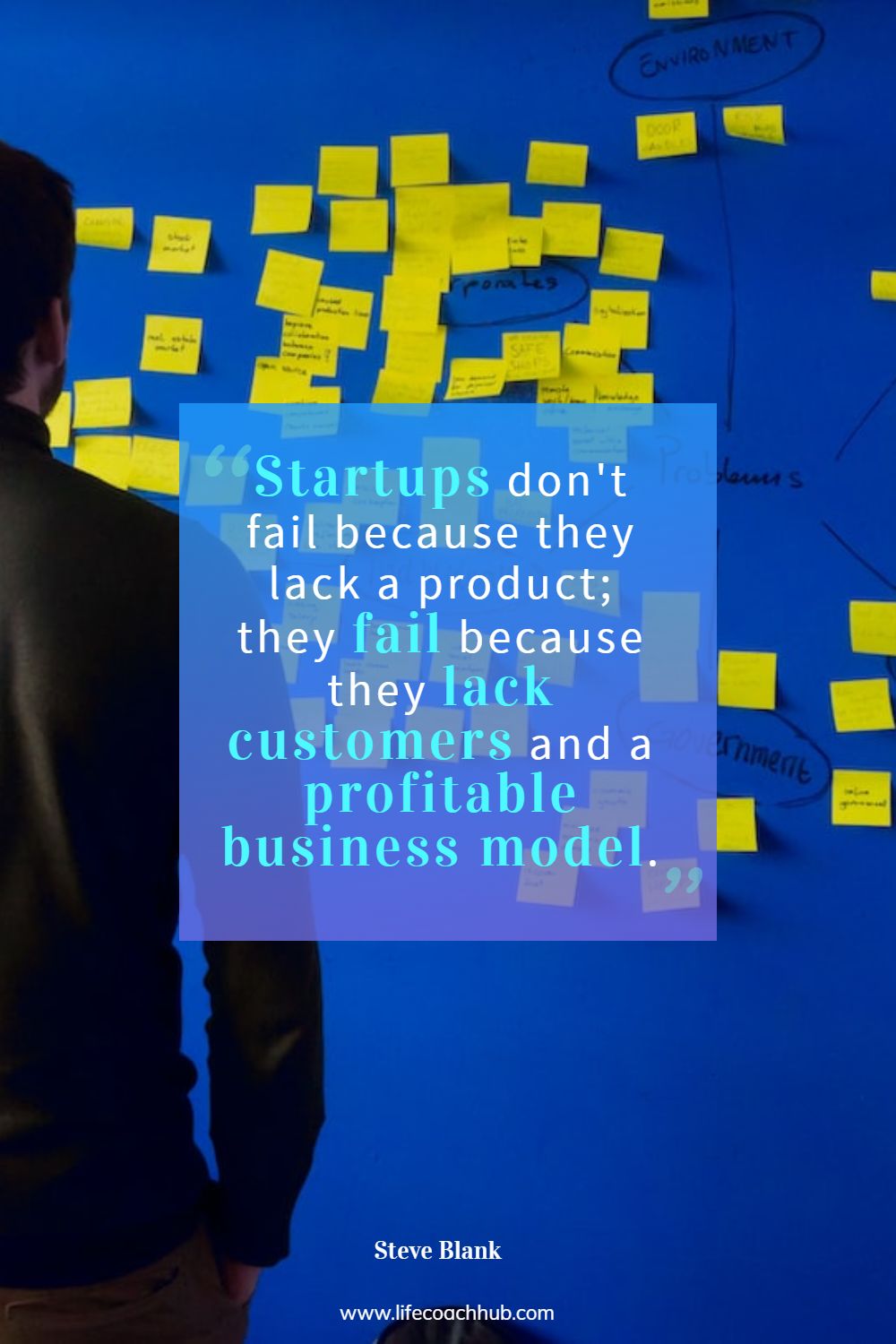
Whether in life or business, starting up is pretty easy compared with sustaining it and making it into a profitable venture.
Most of us have probably been there - the excitement mixed with the wee hours of deep thinking and finding ways to grow our business. There’s a lot we want to achieve but always end up being short on time, which brings up a lot of stress and frustration.
In reality, we can never compete with time because time always wins. You might have completed a coaching proposal before its deadline, but guess what? There’s another task waiting at your door.

Why you need to adopt a coaching business model
We can never run out of things to do and activities we want to explore. So how do we ensure we are running toward the right goals, prospects, and activities? We have to lay a solid foundation by developing an effective coaching business model.
Identifying a coaching business model early on helps you focus on your target clients, coaching style, services, and pricing method. Also, here’s the best part of having a business model - it sets you on the path which allows your business to be profitable. I mean, as business owners, we sort of have that mindset to make money.
But the question is, how do you make sure you gain more profits (and not liabilities) over time?
Now, that’s the ultimate purpose of a business model!
Want to dive into creating your coaching business model? We’ll get to that in a while.
Before that, let’s make sure we are on the same page on what a business model is and also its types. So you’ll have the groundwork for the model that you’ll develop.
What is a business model?
In its simplest sense, a business model is a company’s plan to make profits (Kopp, 2022). Working on your business model allows you to establish three things, these are:
- What products and services will you sell
- Who is your target market
- How much are your projected expenses
But these three elements alone can’t give you the numbers or profitability that you hope for.
You need to dig deeper into how much you’ll charge for the products and services you offer (pricing) and the expenses involved to create something of value and deliver it to your target market (costs). Once you have laid down the pricing and costs, you will then be able to capture the value of your offering through sales or profits.
For startups, it’s best to first cover the basics of your business model before thinking of expanding or adding more products and services.
For example, you need to have cost projections for your new venture starting with marketing or how will you attract your prospects to get your offer. You also have to factor in how many staff you will maintain or if it will just be you at first, and other aspects relating to your company operations.
If you have the needed capital to start, that’s well and good. But what if you’ve just transitioned to your profession and don’t have the funds to initially finance it? How will you finance and effectively manage your business?
These are only a few aspects that need to be addressed when developing your business model.
Oh, and it’s not enough to know the value of your products and services and that of your competitors (which can be other coaches or even educational institutions). You have to be keen on who can be your partners in delivering your offer and other opportunities that you can tap into to save time and money.
Also, we can't talk about a business model without its key component. The main ingredient that sets you apart from your competitors, or what we call the value proposition.
To give you a quick snapshot as we’ll talk about it more later, it basically answers the question, “Why must your prospects get your service?”
So now we’ve laid the groundwork on the basic elements of a business model, let’s jump in to discover its various types. Who knows? It can spark an idea of the kind of business you want to pursue later on.
Types of business models
As the world of business continues to transform, so do the business models evolve to adapt to the ever-changing needs of the market.
We see it every day. Customers crave trendy and cutting-edge products and services, while companies strive to match these shifting needs and wants of customers. The result? Countless businesses and so many types of business models.
But don’t worry, we don’t have to go through all of those models. We’ll only focus on the most popular ones so you get the idea of what kind of business model can apply to your coaching business.
Let’s have a quick view of the popular business models below.
- Retailer. A retailer model is a seller of goods and the one who delivers the products and interacts directly with customers like supermarkets or Walmart.
- Manufacturer. A manufacturer model is a maker of goods that starts by getting raw materials and producing finished products which are either customized or mass-produced like car companies Toyota or Tesla.
- Fee-for-service. A fee-for-service model is used by specialized businesses in providing labor and services. These companies need training or higher education to practice which allows them to charge on an hourly basis or at a specific rate once the services are delivered like construction, consulting, and coaching companies.
- Subscription. The subscription model is used when a company offers its products and services for a fixed period in exchange for payment like cable companies and Netflix.
- Freemium. A freemium model attracts its prospects by initially giving a basic product or service for free. Then afterward, it offers a more upgraded version of it, only that it requires customers to pay a premium like Canva.
- Bundling. A business that uses the bundling model sells multiple products or services to one customer for a discounted price. Some companies use bundled items as a way to attract customers since they are way cheaper compared to when these products are sold individually like insurance companies.
- Marketplace. The marketplace model is a quite simple way to earn profits as a company hosts a platform for businesses and clients to transact. By allowing a fast, easy, and safe business deal, popular e-commerce platforms like Amazon and eBay continue to lead the world of online shopping.
- Affiliate. A company can tie up with a business or a famous personality to promote its products. The one who promotes (or the affiliate) receives compensation through fixed payment, sales percentage, or commission; bloggers, YouTubers, and other social media influencers use the affiliate model.
- Razor blade. A business adopts a razor blade model by selling a specialized or durable product at a low cost and then earns income through expensive parts of the product. Companies like Gilette and HP maximize their profits through expensive blade replacements and printer inks, respectively.
- Reverse razor blade. The reverse razor blade model is the exact opposite of the razor blade since it positions its product as pricey upfront and offers companion products for free or at a low cost, like Apple’s iPhones and its applications.
- Franchise. A company with existing business plans and operations often uses a franchise model or franchising to expand or put up a business in various areas. Fast food restaurants like Starbucks and McDonald’s (franchisor) leverage their established brand by allowing a business owner (franchisee) to use their brand and business model. The franchisor helps promote the business and oversees the operations, then gets a percentage of the sales from the franchisee in return.
- Pay-as-you-go. Unlike the subscription model which charges a fixed fee or period, the pay-as-you-go model only charges how much products and services are used, which is common among utility companies.
- Brokerage. An entity that uses the brokerage model acts as an intermediary by connecting buyers and sellers. The broker then receives a percentage of sales based on the actual cost of a product or service, a model popularly used by real estate brokers.
The 7 Best coaching business models proven to boost your success
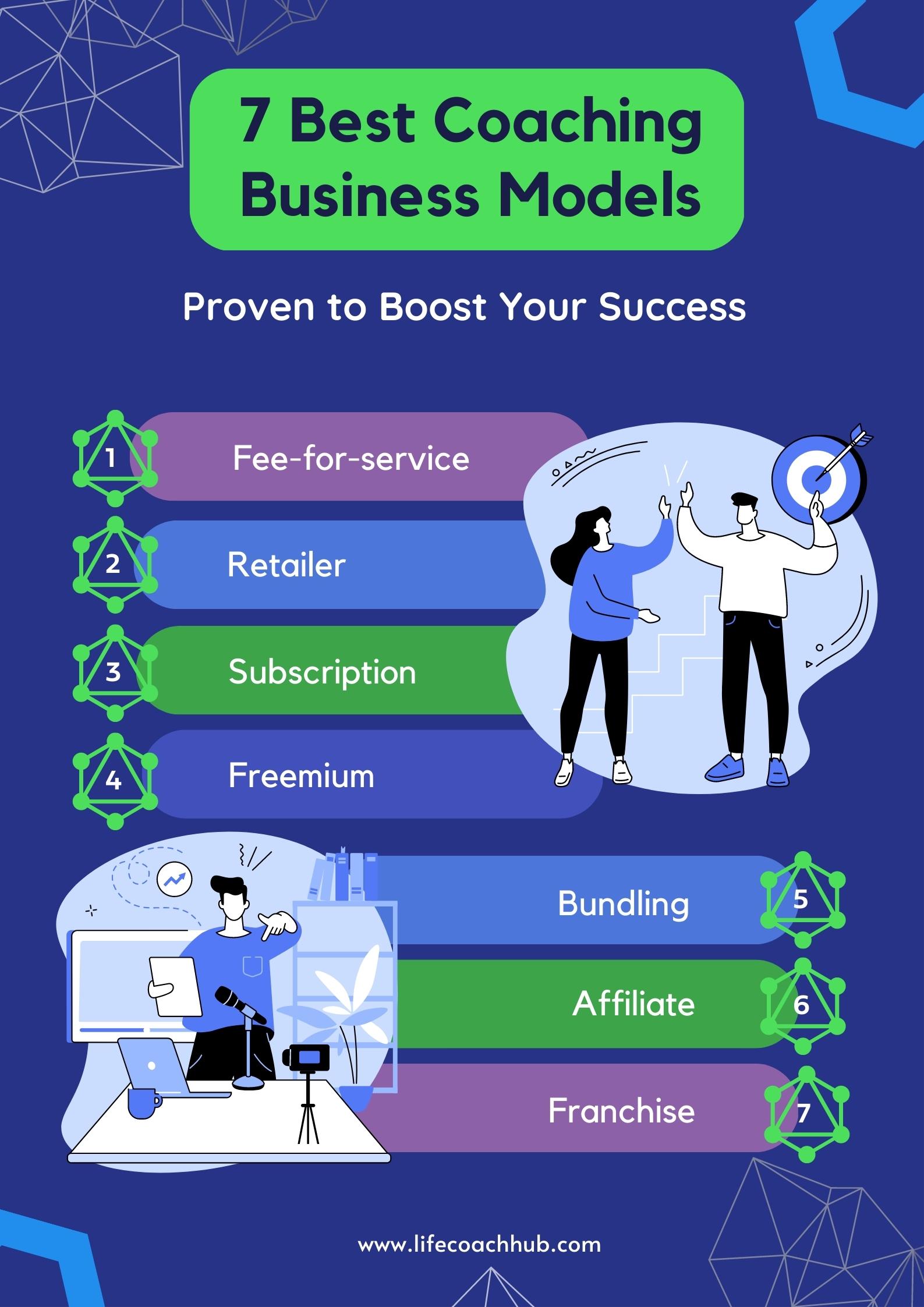
-
Fee-for-service coaching business model
The most popular and simplest way to introduce your services and get paid for delivering them is by using a fee-for-service structure. Most coaches start with this business model since it’s a pretty direct way to transact with clients and earn profits.
With a fee-for-service model, you can charge a certain fee to your client based on the service you provided. When using this model, you have to consider other aspects like the number of coaching hours, the outcome of the coaching session, and follow-ups or progress updates, if any.
Being the simplest and most widely used model, there are various types of fee-for-service. Let’s have a closer look at each type below.
-
Private or one-on-one coaching
This is where most coaching business models originated. It is also the easiest and cheapest to set up as you're basically making an appointment only for two people.

Coaches often give private coaching as their initial session since it’s the most solid approach to building trust and connection. It also requires time and dedication per client, which allows you to put a premium charge per session. But it also saps a lot of your time, since you are trading dollars for hours.
The Global Coach Survey, which gathered 1,380 responses from coaches in over 79 countries, revealed that the average hourly fee paid by their individual clients ranged from $124.50 to $274.36 (Passmore, 2021). (Unsure what to charge? Learn more about setting your fees here.)
As promising as it looks, the main challenge faced by coaches using this method is balancing their time with all the other tasks of coaching, such as getting new clients. It relies on you doing all the coaching and only getting paid for the hours coached. It is very energy-intensive, as you have to be completely focused when coaching. And it puts coaching out of reach for many due to its high cost.
-
Group coaching
Once you’ve picked up the pace and gotten comfortable with one-on-one coaching, you’ll feel it's time to add group coaching to your list of offerings.
By now, you’ve established your brand, and more people like and trust you. Now that’s a good sign! But, it’s making private sessions harder to handle. It’s time to harness the power of groups.

Coaching groups may range in size. It totally depends on how many you can effectively handle! You just have to ensure that you maintain the same zeal and engagement from the group. Here’s a tip: Have a balanced mix of individuals with somewhat similar goals and backgrounds. Use coaching software to make sure you monitor progress and can provide feedback easily.
Unlike private coaching, you can use price as a source of your competitive advantage here. The price you’ll set for group coaching can be lower since you’ll handle several clients at once. That makes it a win-win solution for you and your clients.
-
Online coaching
With the internet by your side, the possibilities to thrive are endless! Since 2019, the online coaching fee-for-service business model continues to grow in popularity.
You’ll have an amazing reach with clients around the globe. You can even get to coach in your pajamas! How cool is that?

First, you need to build your website and create brand messaging that speaks to your audience. Then go one step up by setting up your social media accounts. Leverage platforms such as Facebook, LinkedIn, Twitter, Pinterest, Instagram, YouTube, and TikTok. Explore these platforms and share valuable content using a monthly content plan as your guide.
As you influence more people online, cash and clients can keep coming in (as long as you deliver quality services). Remember to always direct your offer to your target audience and what they highly value. You can also create videos, write articles, or try podcasting to increase your revenue streams.
If there’s a benefit we received from the global pandemic, it’s our ability to make almost everything online, including coaching. It pushed us to embrace everything that’s virtual. This virtual reality is seen among the 98.3% of global coaches who used online coaching from 2019 to 2021 (Passmore, 2021).

Can you guess the popular platform used by coaches? 83.3% managed their sessions through Zoom, while many more used coaching software programs to deliver coaching tools. Clients enjoy experiencing their sessions online for several reasons:
- Convenience
- Safer personal space
- Minimal cost
But clients aren’t the only ones who enjoy this online coaching. Coaches agreed that online coaching brings a positive impact on them.
- There’s less travel
- It enables better use of time
- Allows them to perform more client work
-
Coaching workshops
Conducting workshops can also be a sustainable fee-for-service coaching business model. You only need to initially build a framework for how you plan to perform the workshop. After that, you can offer it to SMEs or large corporations. You can also tweak it from time to time, making it a steady source of income without much sweat.

But, the main challenge here is group engagement, since workshops have to be collaborative to be successful, you have to ensure the active engagement of participants. Also, it takes a certain amount of credibility and authority to allow company executives to sign you up for conferences or workshops.
Still, you won’t need to worry about workshops when it comes to revenue since a workshop is a more specialized coaching offer compared with typical group coaching, it’s also more expensive.
-
Motivational speaking
It only gets bigger and better!
As you build your reputation and credibility, word-of-mouth marketing can take you further. Can you feel it? Get ready as fellow business owners and executives from big organizations will approach you for your services.

Motivational speaking is what a lot of coaches aim for. Why? Because it allows you to influence larger groups while having a more consistent income flow.
Nevertheless, some coaches consider motivational speaking a challenging feat. Yes, the perks are attractive. But it’s quite a difficult area to penetrate as it’s built on trust and relationships.
If you’re up for the challenge and want to walk in the footsteps of several well-known life coaches, here’s what you can do.
- Broaden your reach and exposure through effective networking and by building relationships with various companies’ human resources departments.
- Explore the motivational speaking space and get rewarded with both fulfillment and revenue!
****
Are you eyeing to jump-start your coaching business using the fee-for-service business model? It’s easy to get started, and you’ll get paid for every dollar of coaching you do.
But as you grow your coaching business, you might find fee-for-service challenging to manage. It’s a good start but you can’t scale it. You only have 24 hours in a day. So it’s time to look at some additional coaching business models to add to your repertoire.
-
Retailer coaching business model
One way to expand your business is by adopting the retailer business model. You can still speak to your dream clients, only in larger groups.
There are several ways to use the retailer model to scale your business.
- Offering online courses. (Here are some great course topic ideas).
- Selling books or ebooks
- Crafting on-demand guides, worksheets, or workbooks
Imagine offering these products and earning a passive income stream. You’ll be making money not only when you are actually coaching, but all the hours in between, even when you are sleeping.
Of course you’ll have to invest a lot of effort to plan and organize your offerings initially. You’ll need to focus on structure, content, and pricing. But once they’re done, it’s all about accumulating the rewards!
Here’s the best part. The retailer coaching business model frees up your time so you can manage other tasks and even take long breaks when needed.

-
Subscription coaching business model
Another business model that applies to coaching is the subscription model. The best way to do this is to offer access to a website where potential clients can get membership access.
For example, depending on your client’s membership level, you can give them access to your top content such as basic tips, how-to guides, or some worksheets and planners. The key here is to make sure that what you offer is what your audience needs. Setting up a subscription will allow you to form a longer relationship with your client, and not just a one-time transactional event.
When you allow your clients to have smaller, regular payments over a longer period compared to a one-time upfront transaction, you are also increasing your client’s lifetime value. You might not notice it at the start, but as you grow your subscribers, you are also scaling your company as you begin to retain more customers.
As with the retailer model, once you have properly set up the offerings and perks for the subscription model, you’ll have more time on your hands, so you can focus on the other aspects of your business.
-
Freemium coaching business model
Many companies, especially those offering digital services such as smartphone apps and online graphic design, have turned free users into paying customers with the freemium model.
You don’t have to charge for every course or piece of content. Consider giving away a small course, more access to a membership plan, or extra perks in your coaching to make way for a bigger, more valuable offer that will allow clients to pay more.
The freemium model is often used to attract new clients, since offering a service or product for free is one of the most effective ways to capture them. But it can be a bit of a balancing act.
- On the one hand, if you find you’re not getting or retaining more clients, it can mean that your free offer doesn’t resonate with your prospects.
- But when you have many prospects that are signing up for the free feature but don’t pay for the advanced feature, it can mean that your free offer is too compelling and needs adjusting (Kumar, 2014).
You have to strike a balance between your free offer and the upgraded feature when using the freemium model.
-
Bundling coaching business model
Sometimes, customers become more attracted to products or services when they are sold at a discount, as one package or bundle. Bundling is a strategy that is used for existing clients to encourage them to try other products at a lower cost.
Bundled products and services might include either similar or diverse offerings, as long as they appeal to a target group of clients.
When bundling, it’s best to also mix up your on-demand products and services with those offerings that are somewhat unpopular to stimulate their demand. For example, as a coach, you can offer one-on-one coaching services along with a book and an online course for a discount.
Or, more commonly, just bundle together a batch of coaching sessions as a package. This is the most common way that coaching is offered. For instance, you might offer a three or six-month coaching package that includes one session every week, along with email support. Your clients get their sessions for cheaper, while you get a longer term commitment, and can spend less time chasing new prospects.
Bundling is definitely a popular coaching business model, and one to add to your portfolio.

-
Affiliate coaching business model
As you scale your coaching business and become more influential, other businesses may tap you to advocate their coaching products. Once you promote products and services on behalf of a business, you then act as their affiliate. You can also look for these opportunities yourself on places such as Clickbank.
You may be wondering, how are you going to earn out of it? Well, it’s pretty simple. If an individual becomes a customer through the link you provided in your blog or newsletter, you will gain a commission.
The beauty of becoming an affiliate is you can earn passive income by recommending products that you believe are worthwhile and can help your audience. In most cases, you don’t need to be a popular coach, although it will help if you have a wider audience reach. You just have to advertise their products and complementary services.
-
Franchise coaching business model
The saying “Time is money,” which was believed to be written by Benjamin Franklin, holds true now more than ever. In business, time is one of the key factors to consider whether you’re starting up, scaling, or making investments.
What if you can both have time and money?
In a franchise business model, you can hit both of these crucial aspects. It’s a model guided by a contract between a franchisor who owns an established brand, and a franchisee who borrows the brand, business model, and other intellectual property.
Like any coaching company, your franchise model can stem from a typical small business that offers fee-for-service coaching. Now, as you grow your business and hire more employees, you get to establish your systems and smooth out your business administration. You can then gradually make a transition to adopt franchising.
There are lots of franchise arrangements but here are the two most popular ones:
-
Product franchise
Known as the oldest form of franchising, the product franchise allows franchisees to only sell the products made by the franchisor.
You can relate the product franchise to a supplier and dealer relationship. Only in the supplier-dealer tie-up, the dealer can cater to as many brands as they want. In a product franchise model, the franchisee has to distribute the products on an exclusive or semi-exclusive basis.
-
Business format franchise
The most familiar and widely used franchising model is the business format. When you set up your coaching company and adopt this franchise model, you invite a third party to use your business model, trademark, and other intellectual property. This third party can be an individual or a company. In return for using your model or business idea, they have to pay fees or give a percentage of their sales. You also set the general rules on how your franchisees must conduct the business.
US franchise businesses are expected to increase to over 800,000 establishments and will contribute approximately $520 billion to the US economy (International Franchise Association, 2023). Despite current inflation, the expected total output from franchised businesses will also continue to rise to roughly 4.2% in 2023 and is predicted to reach $860 billion.
Franchising is a good way to grow and expand your coaching business. It’s the most effective way to scale and hire people while being productive and profitable as well.
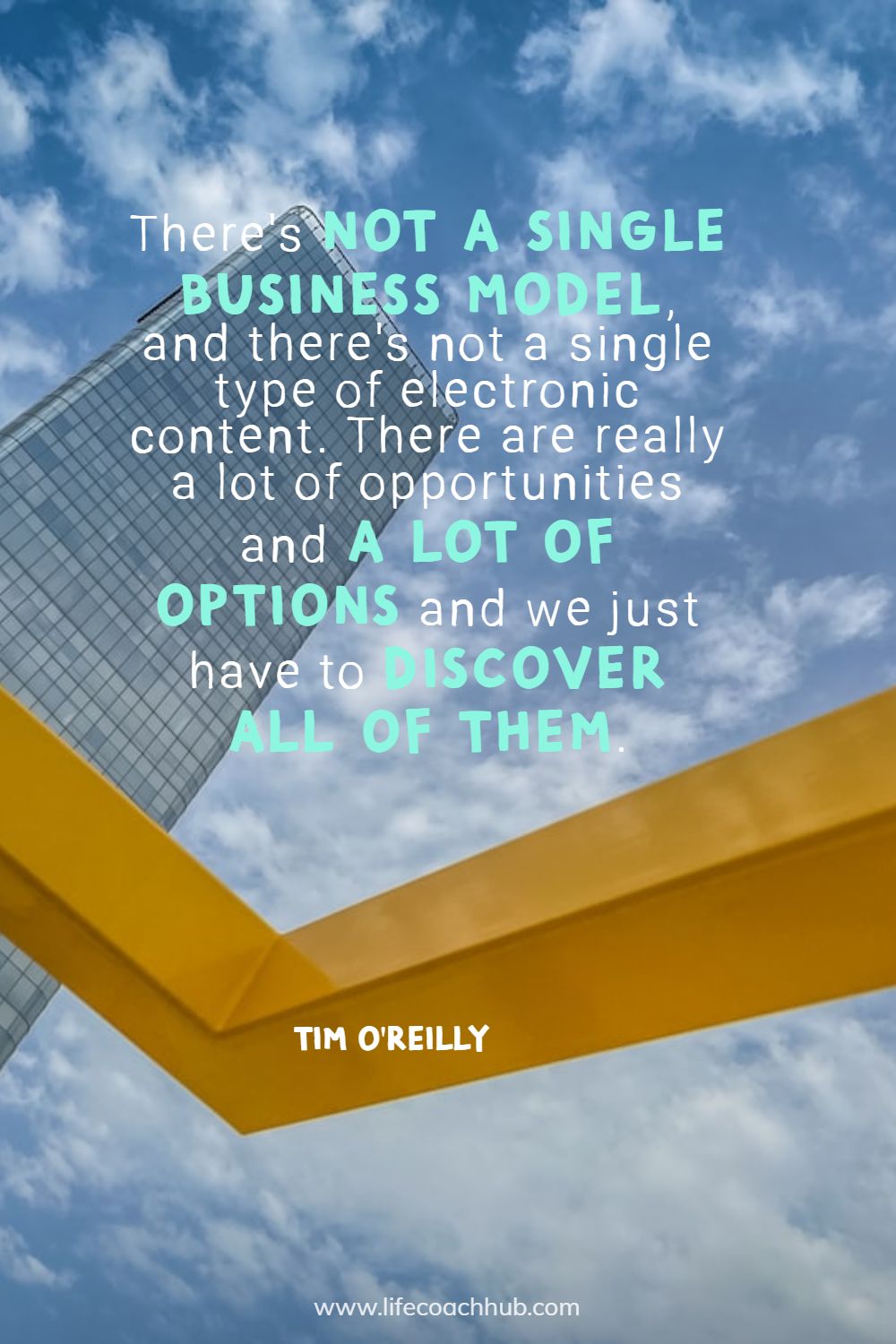
Now that you have an idea of the best coaching business models, let’s try to set up your own.
How to unlock your coaching business model

FourweekMBA defines a business model as “a framework for finding a systematic way to unlock long-term value for an organization while delivering value to customers and capturing value through monetization strategies.” (Cuafano, 2023)
Simply put, your coaching business model is like a cycle. It starts with the value you propose to your prospects. Then to the value you deliver to your clients. And it ends with the value you receive from your marketing and selling activities.
To provide you with a clearer picture, here’s what it looks like.
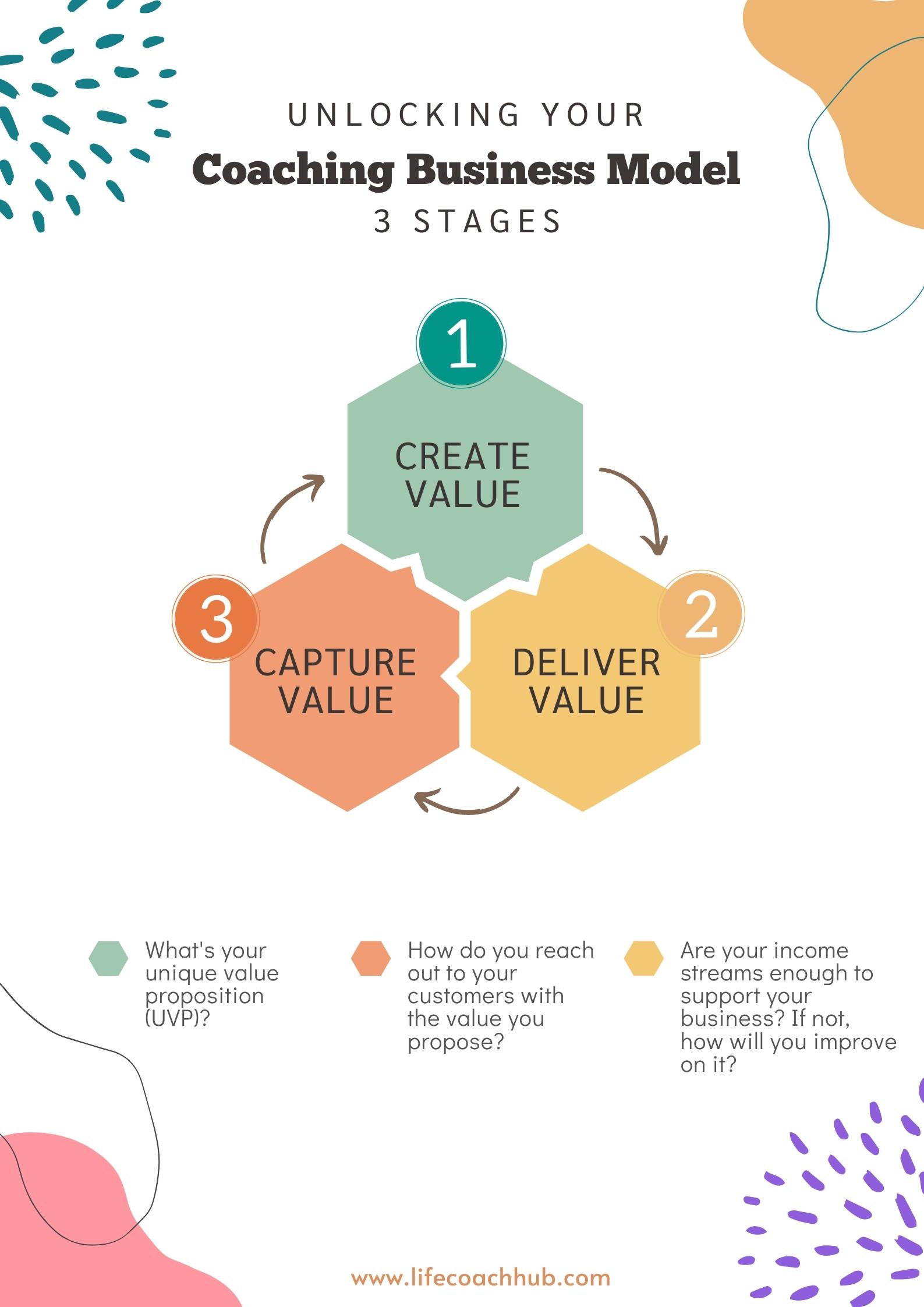
#1 Create value
Truth is, there’s no secret formula to attract your prospects better than offering what your potential client needs.
Standing out against a sea of products and services poses a huge challenge, mainly when you’re starting your coaching business.
You might be thinking, how on earth will you compete against famous coaches with decades of experience? Or how about those Instagram-worthy coaches with thousands of followers? It’s absolutely possible! Truth is, there’s no secret formula to attract your prospects better than offering what your potential client needs.
But how do you know their needs?
Know your why
Before drilling down on the needs you want to address and the value you propose, put some thinking first into your core - your values, beliefs, and purpose. You need to lay the groundwork first.
Understand your thoughts and aspirations. Go back to basics. It’s your key to thriving and achieving long-term success.

Here are some questions to guide and help you self-reflect.
- Why do you want to be a life coach?
- What made you decide to be a life coach?
- What is your purpose?
- What are your goals?
- How do you plan to achieve them?
- What strengths and/or abilities do you have to fulfill your purpose?
- What are your limitations in reaching your goals?
Understanding your motivations and purpose is crucial to effectively coach others to do the same. Once you’ve completed this step, you become officially ready to go out. You can then find and help others solve their concerns.
Use market segmentation to identify your target market
Now, it's time to identify your target market or who you want to help. To many, deciding on your market is already mind-boggling to think about, especially when you’re clueless about conducting research.
Even market researchers face the dilemma of targeting the correct customers. So, to help them establish their target market, they use what they call “market segmentation”. Market segmentation is a technique that allows you to categorize your prospects into smaller groups or segments. Prospects with the same needs or respond to specific marketing activities are classified into groups.

There are four main techniques for segmenting a market, these are:
- Demographics. The most common method of market segmentation. It assumes that customers from similar backgrounds have similar needs. It divides the market according to customer demographics such as age, gender, household income, race, location, education, and occupation.
- Geographic. Technically a subset of demographics since it groups customers based on their location. It assumes that people living in a particular area have similar needs.
- Psychographics. Considered the most challenging of the four techniques. It classifies customers according to their personalities, lifestyle, opinions, and interests.
- Behavioral. Heavily dependent on market trends and consumers’ decision-making patterns and actions. Marketers often use this approach when introducing a new product or service. Since previous buying habits or spending patterns are indicators that affect their future behavior.

Companies find market segmentation extremely valuable as it minimizes the risk of selecting smaller subgroups. It also maintains a clear branding and message that captures its prospects.
Once you’ve figured out your target customers, learn more about their pain points and struggles. List down their main challenge along with the other difficulties they face. Then, come up with creative ways to help them solve their challenges.
Whew! Does it come overwhelming? Well, that’s only to set the stage as you start your coaching business. Gather as much information as you can by performing market research. Know more about your prospects by doing surveys, focus group discussions, and in-depth interviews.
Focus groups and in-depth interviews allow you and your prospects to engage in a discovery talk that is integral to the value-creation process. As you dig deeper, you’ll find yourself brainstorming on your best offer based on your customer needs.

Establish your unique value proposition
Think of an effective way to market your products and services to your target clients. How do you make an offer that would be difficult for them to refuse? Here’s your secret sauce: use a unique value proposition.
The research on your target market’s needs, pain points, and aspirations comes in handy at this point. Supported by data on industry trends, you ensure that you are targeting the right clients. Research will also guide you in creating high-value services that aim to help your prospects.
So you have a target market and highly valued services… now what? Think of an effective way to market your products and services to your target clients. How do you make an offer that would be difficult for them to refuse? Here’s your secret sauce: use a unique value proposition.
A unique value proposition (UVP), also known as a unique selling proposition (USP), is your company’s short statement that communicates your one-of-a-kind service or product.
The best way to come up with a UVP is by doing a quick environmental scan. Look around you. Get to know what kinds of coaching services are currently available in your area. Also, explore what types of clients need such services and how are these services delivered.
Now, use your research and lay down what your target market needs. Search for gaps by taking a closer look at what other coaching products and services are not being offered but your prospects need. At this point, you want to make your offering different but still suit the taste of your audience.
You will also want to narrow down your UVP by selecting a niche in which you can specialize in and satisfy that specific group’s needs and wants.
For example, if you are a motivational coach and you want to focus on young professionals between 25 to 40 years old, this is still a big chunk of the market. So you can try to zoom in some more and just cater to this age group but in areas of career, relationships, or health and wellness. But of course, you also have to make an inventory first of your skills, passions, and experiences since coaching entails walking the talk.
More than a tagline, your UVP must be clear enough to convey the solution you promise. It’s a clever technique to connect instantly with your prospects. Your value proposition must communicate why they must choose you over your competitors.
Here’s an example of a value proposition and tagline from Apple.
- Value proposition: “The best experiences. Only on Apple.”
- Tagline: “Think Different.”

#2 Deliver value
Once you’ve set up your promise of value to your target clients, get ready with your mode of delivery.
Choose your approach
Now that you know your prospects, it’s time to identify the best way to deliver your value proposition. Are you going to use online or face-to-face coaching?
Online coaching has continued to develop in popularity ever since the pandemic. And, why not? Both coach and coachee have grown to love this method. Yet, for others, nothing beats traditional face-to-face coaching, as it is a more personal approach to delivering your services and involves minimal distractions.
Still torn on how you want to reach your prospects? Use these questions to guide you in delivering your best offer.
- Where are your target clients physically located?
- How do your prospects engage in social media, podcasts, and videos?
- How prepared are you to conduct online coaching sessions?
- What are the best possible options to deliver your offer to your potential clients?
- What are the expected costs of choosing each method vs. the possible returns?
While you’re at it, get creative and resourceful in reaching your prospects. Explore various approaches and mix and match what’s best for you. You can even end up with a hybrid method if it’s the most suitable, engaging, and of course, profitable.
Add extra value for clients
Once you get the hang of running your coaching business, make a conscious effort to keep your clients happy and satisfied.
Adding extra value to the services you provide for your clients doesn’t always have to involve additional costs. You can start by making each session, workshop, or speaking engagement fun and interactive. Are you still sending emails back and forth for appointments, coaching plans, and onboarding, wasting your time and leaving your clients with an unprofessional impression?
These processes can all be automated and streamlined so you’ll have more time on your hands. Using a coaching software platform such as the one we offer will allow you to manage your time more effectively, eliminating the chaos and waiting time to reach your clients efficiently.
Our software platform also lets you make your coaching more interactive by assigning journal assignments, action items, goals and worksheets. Keep your client focussed and motivated towards their goals. They will keep coming back and also share through word of mouth about your personal touch. Take a free test drive here.
#3 Capture value
Here’s the thrilling part! Once you’ve completed delivering your services, it’s time to check the results.
We get it. As a life coach, you long to help others realize their potential. But you need to get real about making it profitable if you want to sustain it.
Check out these questions and capture the value of your strategies.
- How would you price your services? What are the different packages you can offer to your prospects?
- What are your revenue streams for your coaching business? How can you make them more appealing to capture your target clients?
- Are there other revenue streams you can tap into that are not as popular as the others but generate more income?
Coaching can be a profitable venture. Indeed, coaching’s contribution to global revenue climbed by 21% from 2015 to 2019, bringing it to $2.849 billion (International Coaching Federation, 2020).
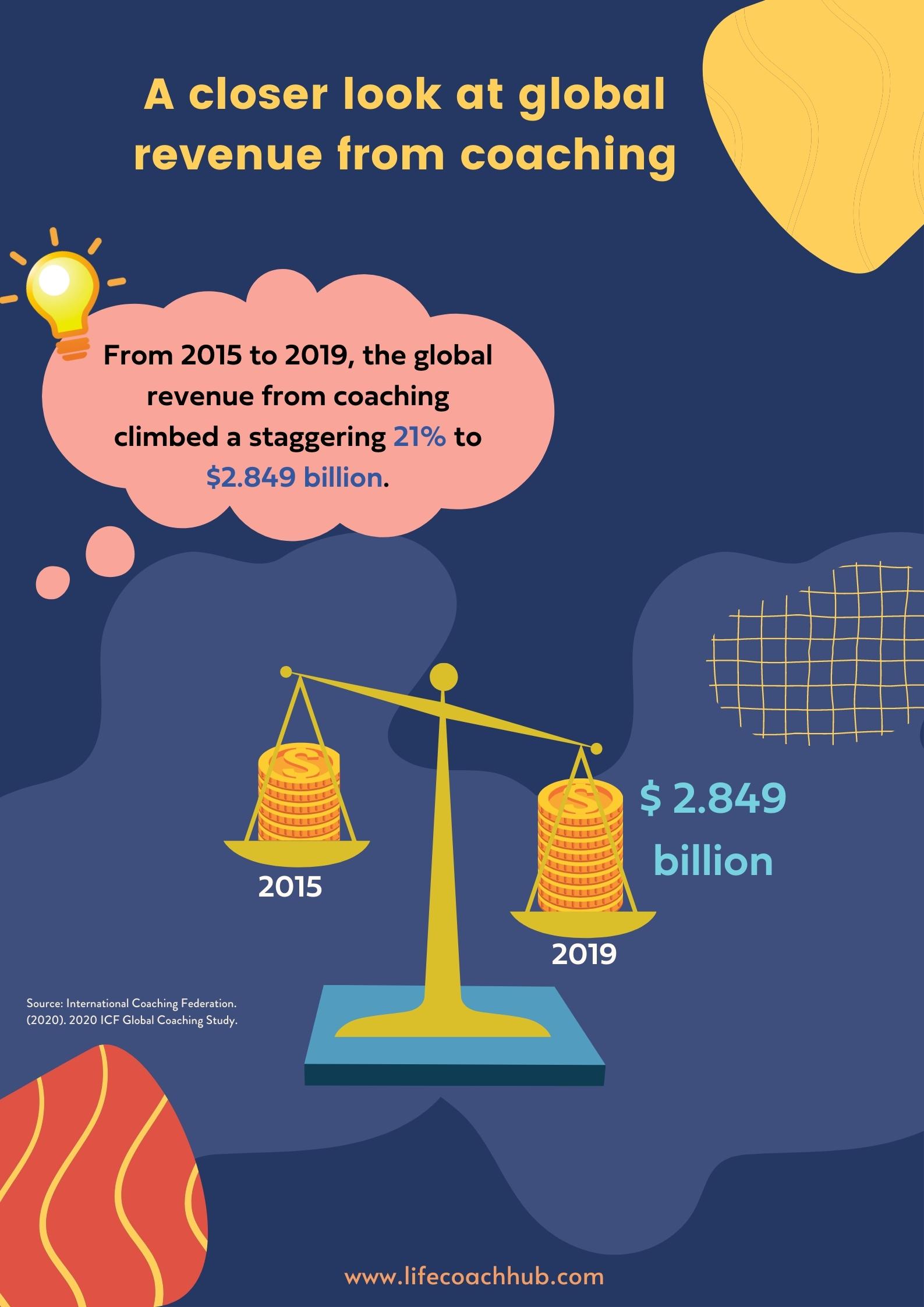
Now, let’s try to picture how much of the pie you’re actually getting.
It’s a “pro” move to consistently set measures and gauge how well you are doing with your business. Use these five pillars of effective marketing to track the results and capture the value of your coaching strategies.
Using quantifiable indicators allows you to check your business strategies’ effectiveness and profitability.
Five Pillars of effective marketing
- Market measures. The typical indicators of your appeal and credibility as a brand.
Test your brand’s strength in capturing your market through the following questions:
a. Brand awareness: Does the life coaching market know who you are and what coaching products and services you offer?
b. Brand perception: How does your target market perceive you?
c. Brand credibility: Are you someone with influence or authority in your chosen niche?
- Engagement measures. The indicators of your target market's engagement are also capable of driving your sales and conversions.
Assess your prospects’ engagement by answering these points:
a. Brand trust: How well do your prospects listen to what you say/offer?
b. Brand engagement: Do you get your expected reactions toward your marketing efforts? How many clicks, likes, or shares does your post get on social media?
c. What can you improve on to increase engagement and reach your targets?
- Customer measures. These metrics show your reach, influence, and credibility as a brand.
Questions your brand must answer to get deeper with your customers:
a. What is your customer lifetime value (LTV)? The LTV is the total revenue your company expects from each of your customers throughout your business relationship.
b. How well do you keep each customer so they don't shift to other coaches?
c. What are the results of your lead generation strategies?
- Revenue measures. The ultimate gauge of your coaching business effectiveness.
Questions your coaching business must answer to check its profitability.
a. Are you hitting your sales targets?
b. How well do you earn profits compared with fellow coaches?
c. Overall, what percentage of the pie are you getting as a life coach?
d. What coaching activities generate more sales at a lesser cost?
- Risk measures. The risk and losses related to your coaching services.
Questions your brand must answer to balance the risk and losses:
a. What is the value at risk that your company may experience? How much are your incurred losses from conducting free sessions?
b. How many potential clients convert into actual paying clients after a free session?
Finding it difficult to visualize? How about a more concrete example? Let’s look at the example start-up coaching company below to find out how to apply these marketing pillars to your own coaching business.
Example using a health and wellness coaching business
Company Name: Wellness Wheel Achiever
Target market: Young professionals between 25 to 40 years old.
Coaching niche: Career-oriented individuals who are either single or married and have difficulty balancing work and personal life. As a result, they spend little to no time on their health and wellness.
Unique Value Proposition (UVP): Start investing in your health and wellness the moment you begin working. Learn simple tricks to keep your mind and body healthy and you'll thank yourself later.
Business model: Fee-for-service that uses online coaching
-
Market measures
a. Brand awareness: Does the life coaching market know who you are and what coaching products and services you offer?
REALITY: As a health and wellness coaching startup that is operating for less than two years, only a small portion of the life coaching market (within your locality) knows who you are and the online services you offer.
GOAL: To increase your exposure across several states and even to other countries
b. Brand perception: How does your target market perceive you?
REALITY: Your coaching services are helpful, but many perceive your coaching company as something similar to others that are available.
GOAL: Develop your brand positioning as an overall health and wellness coach that seeks to support them in achieving their physical, intellectual, occupational, emotional, social, financial, spiritual, and environmental wellness (aka the wellness wheel).
c. Brand credibility: Are you someone with influence or authority in health and wellness when compared with other coaches?
REALITY: You definitely have influence and authority in providing coaching services but you need more experience and exposure to build your name and your business.
GOAL: Enhance your coaching services’ visibility and leverage referrals to build credibility.

2. Engagement measures
a. Brand trust: How well do your prospects listen to what you offer, and start investing in health and wellness early on?
REALITY: As expected, your prospects believe in starting young to achieve holistic wellness despite the challenges in their career and personal life.
GOAL: Deepen brand trust to make these prospects into paying and loyal clients.
b. Brand engagement: Do you receive your expected reactions toward your marketing efforts? How many clicks, likes, or shares do your posts receive on social media?
REALITY: Your marketing efforts are driving your prospects to come to know and develop an interest in your coaching offers, but they aren’t getting enough likes or comments.
GOAL: Create a social media plan, and post helpful content directed to your prospects regularly.
c. Improving brand engagement: What can you improve on to increase engagement and reach your targets?
REALITY: Your marketing efforts need to be more strategic and sustainable to boost engagement since there are lots of health and wellness coaches.
GOAL: Get to know where your prospects often hang out and what social media platforms they use then build your audience from there.
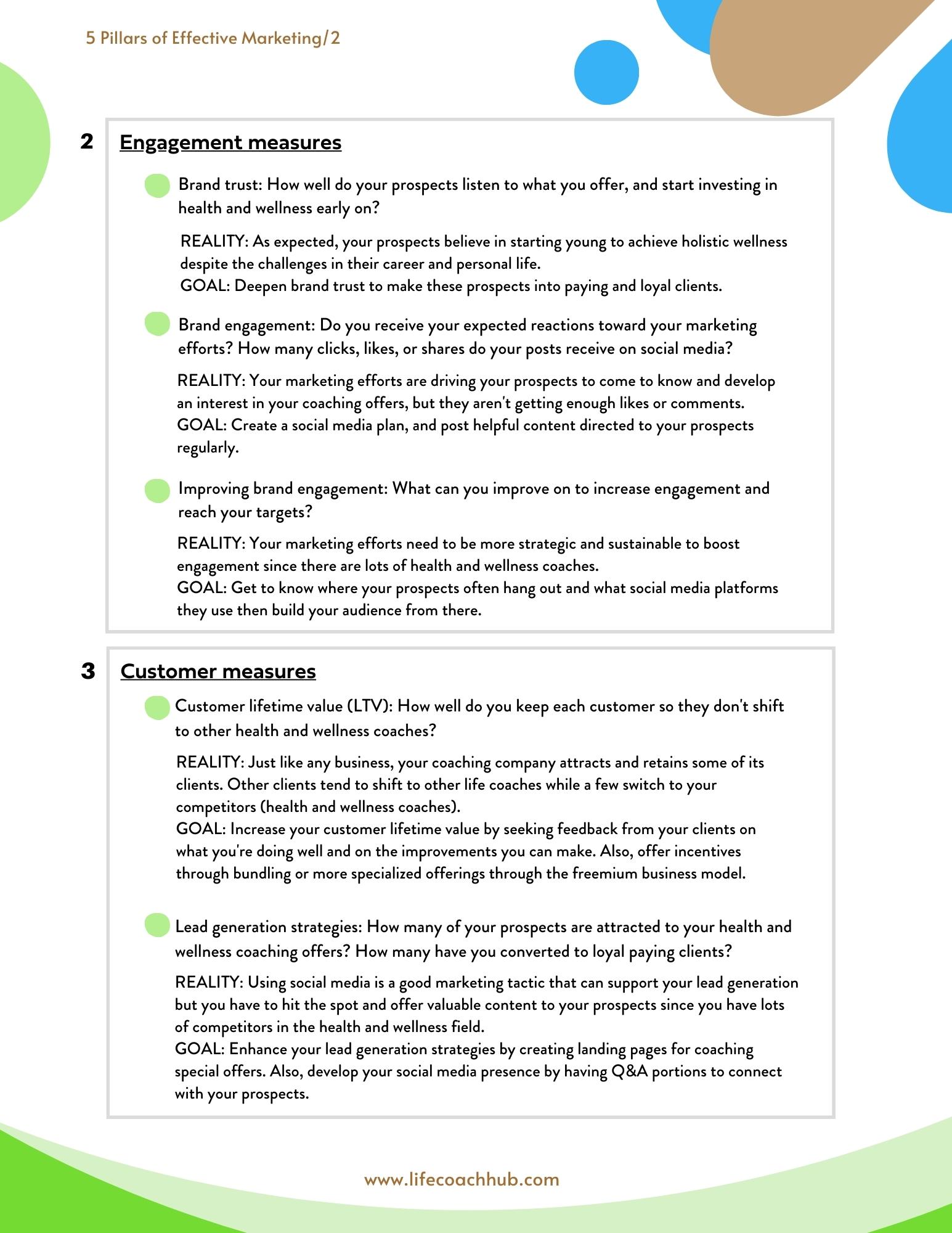
3. Customer measures
a. Customer lifetime value (LTV): How well do you keep each customer so they don't shift to other health and wellness coaches?
REALITY: Just like any business, your coaching company attracts and retains some of its clients. Other clients tend to shift to other life coaches while a few switch to your competitors (health and wellness coaches).
GOAL: Increase your customer lifetime value by seeking feedback from your clients on what you're doing well and on the improvements you can make. Also, offer incentives through bundling or more specialized offerings through the freemium business model.
b. Lead generation strategies: How many of your prospects are attracted to your health and wellness coaching offers? How many have you converted to loyal paying clients?
REALITY: Using social media is a good marketing tactic that can support your lead generation but you have to hit the spot and offer valuable content to your prospects since you have lots of competitors in the health and wellness field.
GOAL: Enhance your lead generation strategies by creating landing pages for coaching special offers. Also, develop your social media presence by having Q&A portions to connect with your prospects.
4. Revenue measures.
a. Profitability check: Are you hitting your sales targets?
REALITY: As a startup, you are making profits but fall short of meeting your sales targets.
GOAL: To reach your target profit, you need to attract more clients, set aside more time to accommodate more coaching sessions or offer other services like coaching courses.
b. Niche market share: How well do you earn profits compared with fellow health and wellness coaches?
REALITY: There's still much to improve to increase your profits and be at par with other health and wellness coaches.
GOAL: There are many options to gain more market share in your chosen niche, consider making your coaching services more affordable, strengthening client relationships, and more quality coaching sessions.
c. Coaching industry market share: What percentage of the pie are you getting as a life coach?
REALITY: Health and wellness coaches are in demand, especially now. So get your fair share of the profits and never stop reaching out to prospects.
GOAL: Go out and meet your prospects where they are.
- Attend conferences and networking events
- Join social media groups
- Offer free sessions or discounts
- Set up your website
- Leverage referrals and offer incentives
d. Re-prioritize coaching services: What coaching services generate more sales and are cheaper to manage?
REALITY: As a new coach, it's a typical strategy to use the fee-for-service or have one-on-one coaching sessions.
GOAL: It's okay to start off with this model but don't stay in it for too long. Start diversifying your offerings so you can create passive income, and make money work for you.
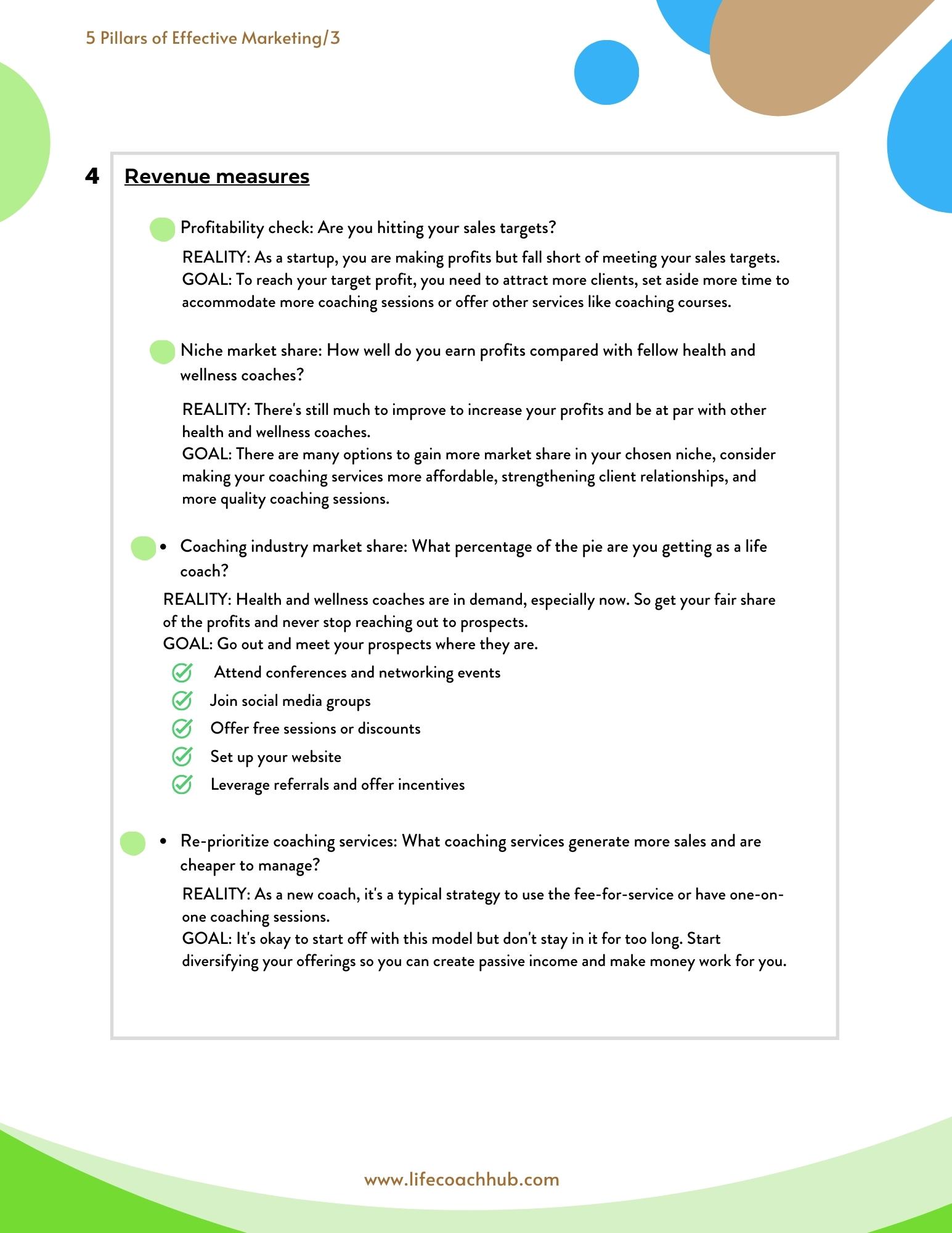
5. Risk measures
a. Value at risk (VAR): What is the value at risk that your company may experience?
Historical VAR 1: How much are your incurred losses from conducting free sessions?
REALITY: You become happy when more people sign up for your free sessions.
GOAL: Offering free sessions can help you attract more prospects but don't get swamped with coaching sessions. The only way to grow your company and use your time the way you want it to is by diversifying your income streams to courses and other offerings, to help you earn a passive income.
b. Historical VAR 2: How many potential clients convert into actual paying clients after a free session?
REALITY: You get less than 20% of paying clients after offering free coaching sessions.
GOAL: Find out which specific segment of those who get free sessions is actually converting to paying clients, and focus on them to give you greater returns.

Using quantifiable indicators allows you to check your business strategies’ effectiveness and profitability. With these measures, you’ll know what aspects to change, continue, or stop. Ultimately, these pillars enhance your value capture to boost your company’s profitability.
Get your pdf copy of the 5 pillars here.

Wrapping up
Having a coaching business model ensures the alignment of your goals, purpose, and strategies - a critical factor in building a successful coaching company. Start by sketching your own business model. Explore your options, and thrive!
FAQ
-
How can I scale my coaching business?
There are numerous ways to scale your coaching business. But it all depends on your focus and how you take an active role in growing your company.
Here are three main ways to scale your coaching business.
a. Develop new products and services
b. Find ways to effectively and efficiently deliver your products/services to your prospects
c. Make bold steps to achieve productivity and efficiency in operations
-
How do I build a successful coaching business?
Ready to jumpstart your business? Cover these basics to set your coaching business to success on the route to success.
a. Know yourself. Know your abilities, goals, sources of motivation, and purpose. Deep dive into what you really want, including what you don’t like, and be clear with it.
b. Know your prospects. Establish who you want to serve or work with and pay attention to where you can find or reach them.
c. Identify your marketing strategies. Determine the best possible ways you can reach and connect with your prospects.
d. Create a don’t-do list. You might have prepared a long to-do list already. To give you a breather, retrieve your to-do list, then analyze the things that derail you from your goals. Transfer these “distractions'' to your don’t-do list to keep you focused.
-
What is the easiest way to complete my coaching business plan?
There’s no better way to build or grow your business than by starting with a business plan. The easiest way to complete your business plan is by ensuring you mark all the essential components before drilling down to the specifics.
Let’s look at the 8 main elements of a coaching business plan.
a. Executive summary
b. Company overview
c. Goals
d. Products and services
e. Market analysis
f. Marketing and sales strategy
g. Operations
h. Financial analysis and projections




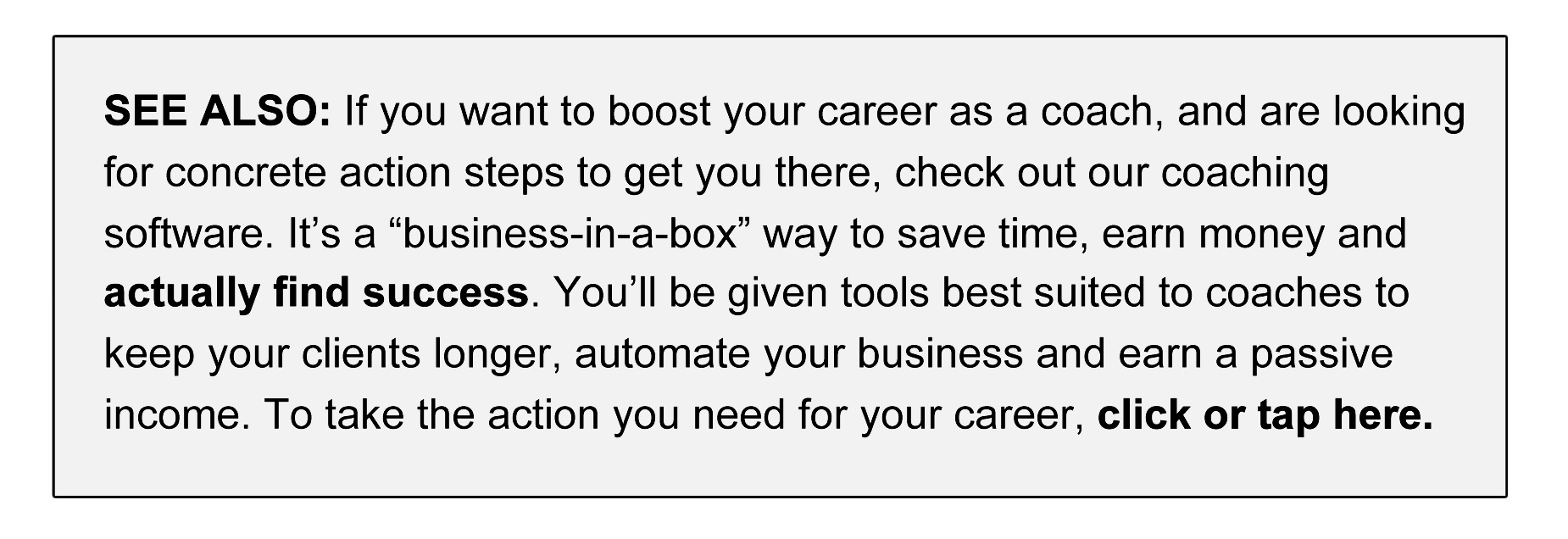

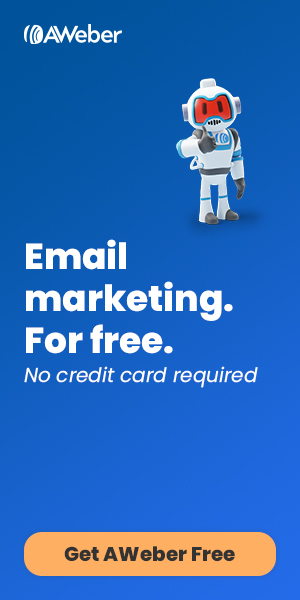













COMMENTS